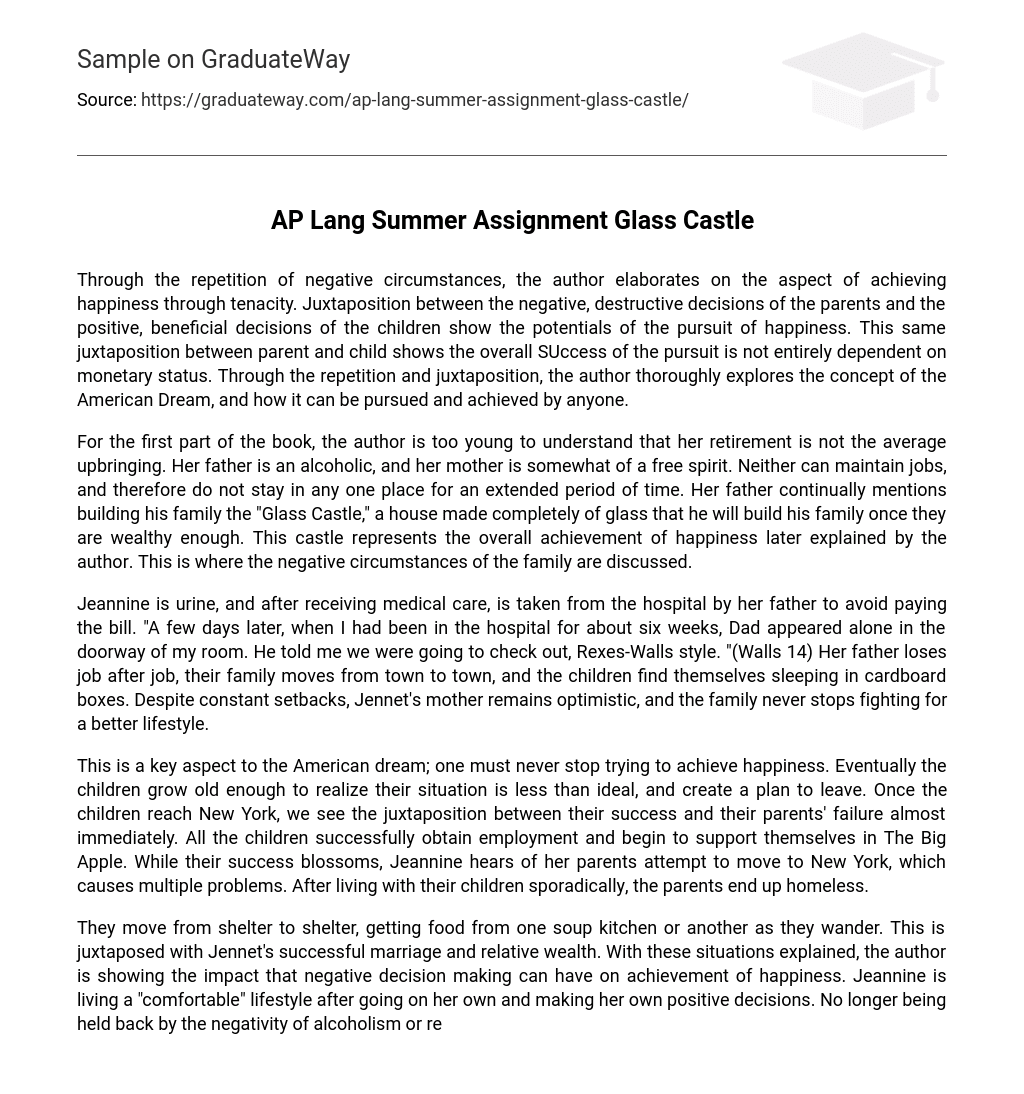The author examines how perseverance can lead to happiness by repeatedly portraying negative situations. By contrasting the unfavorable choices of parents with the advantageous decisions made by their children, the author proves that it is possible to seek happiness. This juxtaposition also implies that one’s financial status does not solely determine success in pursuing happiness. Through repetition and contrast, the author thoroughly explores the concept of the American Dream and its accessibility for everyone.
During the initial part of the book, the author realizes that her upbringing is not ordinary due to her parents’ unconventional lifestyles. Her father’s addiction to alcohol and her mother’s desire for a free-spirited life prevent them from holding steady jobs, resulting in frequent relocations. Throughout the story, the author’s father frequently talks about constructing an impressive “Glass Castle” for their family as a symbol of hope for a brighter future. It is within this context that the book explores the challenging situations encountered by the author’s family.
After Jeannine is released from the hospital, her father tells her about their unorthodox departure (Walls 14). Due to his struggle to find stable work, they often have to move and sleep in makeshift shelters. Despite these difficulties, Jeannine’s mother stays optimistic and determined to build a better future for their family.
This is the essence of the American dream – the constant pursuit of happiness. As they grow older, the children realize that their current situation is not ideal and come up with a plan to leave. When they arrive in New York, there is a clear contrast between their successes and their parents’ failures. In the busy city, the children are able to find jobs and support themselves. However, Jeannine’s discovery about her parents’ attempt to move to New York adds complexity to their achievements. Ultimately, after living with their children for a while, the parents end up without a place to call home.
The text highlights the contrast between different individuals’ living situations. While some people like Jennet face homelessness and rely on soup kitchens for food, others like Jeannine enjoy a successful marriage and a comfortable lifestyle. The author uses these examples to illustrate the consequences of negative decision making on one’s ability to achieve happiness. Jeannine, who has made positive choices and overcome challenges such as alcoholism and unemployment, is now experiencing a rapid increase in her happiness. I told my mom, “I’m doing very well”.
In the memoir, there is a contrast between the narrator’s comfortable lifestyle and her mother’s concerns about her values. The mother worries that her daughter has compromised her principles by living comfortably, and even suggests that she might become a member of the Republican party. Meanwhile, the parents’ unhappiness deepens due to their poor life choices and lack of drive to find happiness. The memoir consistently highlights this juxtaposition to explore the true nature of happiness. Despite this, the children have managed to achieve success in their own ways; they are able to support themselves, maintain employment, and find happiness.
Concurrently, the parents have discovered their own identity as homeless individuals and have formed connections with others in similar circumstances. They have also found contentment in their situation, showing that happiness is not solely dependent on social status. Despite the children having financial means while the parents do not, all parties have achieved happiness. Tragically, Maureen fatally stabs their mother and their father experiences a fatal heart attack. These incidents lead Jeannine to divorce her husband and start anew. After many years, the family reunites and reflects on the past alongside their father.
Maureen’s integration into the family is anticipated with satisfaction by everyone involved. The author effectively emphasizes the significance of perseverance in attaining happiness through consistent emphasis on unfavorable circumstances. Furthermore, the author highlights the impact of choices and different levels of happiness among individuals by contrasting the relatively advantaged children with their disadvantaged parents. Altogether, this offers a comprehensive insight into achieving ultimate happiness, referred to as the “Glass Castle.”
Works Cited Walls, Jennet. The Glass Castle. New York: Scribner’s, 2005. Print.





